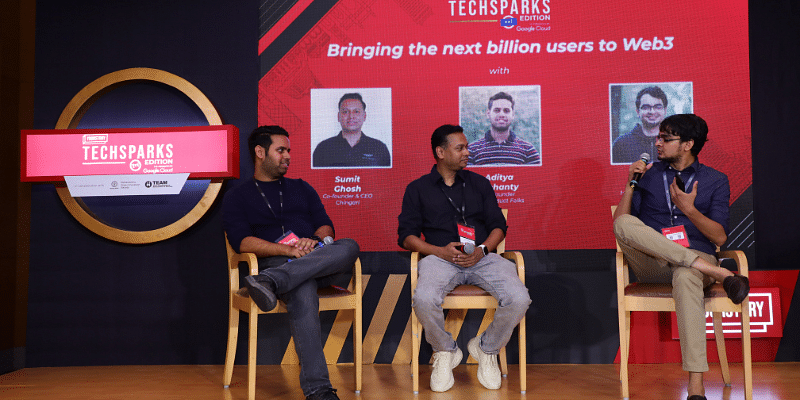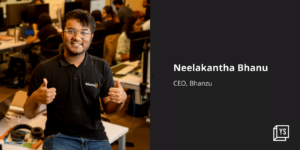India has been swept up in the Web3 wave, with blockchain and NFTs infiltrating numerous industries from entertainment to gaming and beyond.
Web3 is poised to be a critical player as India works towards its $5 trillion economy dream. However, while the potential benefits of embracing this new technology are significant, it also brings along many challenges.
The Mumbai edition of TechSparks 2023 hosted a panel discussion where Sumit Ghosh, CEO and Co-founder, Chingari, the world’s leading web3 short video app and Aditya Mohanty, Co-founder, The Product Folks, delved into the opportunities and challenges that lie ahead as India navigates the ever-evolving landscape of Web3, the various approaches for attracting mainstream audiences, and strategies for engaging people unfamiliar with Web3.
Leveraging gaming and social media as an approach
Discussions focused on two approaches to bringing mainstream audiences onto Web3. The first related to users familiar with wallets, transactions, and blockchain networks. The second approach involves those who are unfamiliar with Web3 but who would like to use a better product.
Ghosh said Chingari started as a “normal web2 2 short video app” that got traction when TikTok was banned in India. “We woke up and saw 13 million downloads in that week. Then we raised some money and built what it is today,”.
Currently, Chingari is one of the fastest-growing on-chain social apps in the world, and the founder believes gaming and social media will be the two verticals that will enable it to reach the next billion users.
“Chingari is building a first-on-chain social experience where users can earn cryptocurrency by participating in social media activities,” he said.
Mohanty, who also founded The Product Folks, the largest voluntary product management community, and Grab Chai, which has now hosted over 20K+ conversations, discussed how his company, Product Folks, has educated hundreds of thousands of users about Web3.
Both speakers agreed that gaming, social media, and communication are critical to attracting the next billion users to Web3.
Mass adoption requires a seamless product
The key to the growth of the decentralised ecosystem is building a product that works seamlessly on both Web2 and Web3.
Ghosh stressed the importance of creating a product that users can enjoy without having to understand the backend of Web3 technology. By leveraging the Solana blockchain, he was able to settle transactions without interfering with the user experience for their short video app.
He said users are not required to understand how blockchains work; rather, they should focus on the user experience that meets their needs. This, he said, is the most effective way to introduce the average Web2 user to Web3 without them realising it.
It is crucial to understand who the user is in Web3. Many projects cater primarily to the Web3 side of the ecosystem, which includes traders and investors rather than actual end users. We need to build products for users and make them better for the market to make the decentralised ecosystem successful, Ghosh said.
According to Mohanty, the company’s community of 150,000 members is currently helping people build products for users at a grassroots level.
Product Folks is a community of Web2 professionals, such as product managers, designers, and marketers. When the Web3 boom began, they were curious and created a sub-community to educate members. Mohanty believes Web3 technology can be used to provide a solution to a user’s problem.
Web3 technology should be used to provide solutions without disrupting the user experience. Educating users about Web3 technology is also crucial to driving mass adoption. The decentralised ecosystem will be more accessible to everyone with more user-friendly applications.
Learning from Chingari’s success
The potential for growth and development in the Web3 space makes it vital to identify the most effective ways to bridge the knowledge gap and seize opportunities presented by this emerging technology.
With more than 2.7 million on-chain wallet users, Chingari, a video-sharing platform built on the Solana blockchain, has become one of the most active social projects on any blockchain worldwide.
It is the largest Web3 project in the history of the world, and is the most active social project on any blockchain globally, with over 600,000 active on-chain users participating in the GARI engagement programme each month, and more than 150,000 active on-chain users every day.
Ghosh said unless a project can build a product with a real use case and utility, it will only attract speculators or traders into its token. He emphasised that for a Web3 project to succeed, it is crucial to tap into a large user base and convert them to on-chain users by creating inherent utility within the token. Chingari has been able to achieve this by offering Gari tokens to its users when they engage on the app ; these tokens can be converted into fiat currency through crypto exchanges.
Chingari’s value proposition is simple. While Instagram monetises user-generated content, Chingari enables content creators to maintain ownership of their content as an NFT on Solana. Its success demonstrates the importance of creating inherent utility within a project’s token and tapping into a large user base to convert them into on-chain users.
As more creators realise the value of owning their content for life and receiving commissions on trades, Web3 platforms like Chingari will continue to grow and challenge Web2 platforms.
Risk management in Web3 startups
The speakers discussed the need for better risk management protocols and frameworks in the crypto space, especially when dealing with disruptive technology like Web3. They highlighted the failures of centralised exchanges, recommended the use of decentralised exchanges, and focused on the importance of controlling one’s tokens and keys.
Ghosh and Mohanty acknowledged the doubt associated with the crypto space, and urged the community to come together to raise awareness and separate truth from speculation.
The panel ended with a question on how startups can get the next billion users into Web3.
Ghosh suggested that startups should use decentralised exchanges and keep their crypto in cold wallets to maintain control over their funds.
Mohanty added that fear, uncertainty, and doubt (FUD) often arise in times of industry troughs, but the ecosystem needs to raise awareness “around the truth of what’s happening in Web3 beyond just crypto”.
He concluded the discussion by emphasising the importance of education and awareness in the Web3 community to see the potential for growth despite the uncertainties caused by the Black Swan events. He addressed the need for media support to separate truth from fear and highlighted the success of Web3-based Chingari as “an example of adoption and engagement”.
Ultimately, Mohanty said, all members of the community should play a part in bringing more users to Web3 by educating them and collaborating with them.











